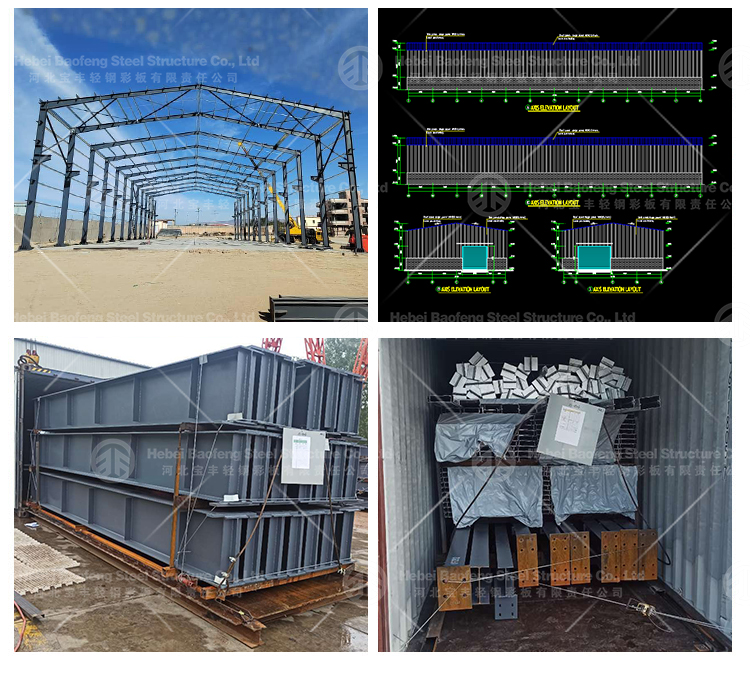
CONSTRUCTION OF STEEL WAREHOUSE AND RELEVANT CONSIDERATIONS
Introduction: With the continuous development of industrialization and the increase in global trade, steel warehouses have become widely used in various industries as modern and efficient storage facilities. Steel warehouses offer advantages such as high load-bearing capacity, short construction cycles, and reusability. However, before constructing a steel warehouse, it is essential to consider a series of important issues to ensure safety, durability, and cost-effectiveness. This article will discuss the considerations involved in the construction of a steel warehouse and the key factors that should be taken into account.
I. Considerations during the Design Phase: 1.1 Site Selection and Planning: When selecting a site, factors such as the required area, shape, and geographic location of the warehouse need to be considered. It is also crucial to assess the geological conditions and bearing capacity of the land to ensure it can support the weight and load of the steel warehouse. 1.2 Structural Design and Optimization: The structural design of the steel warehouse should be based on thorough engineering calculations and optimization. Considering the intended use of the warehouse and its required load-bearing capacity, designers should select appropriate steel specifications and connection methods while ensuring structural stability and seismic performance. 1.3 System Integration and Functional Planning: During the design phase, careful consideration should be given to the functional requirements of the warehouse, including storage and management methods for goods, circulation paths, and the integration with other facilities. Future expansion needs should also be taken into account to facilitate convenient expansion during the construction phase or future modifications.
II. Considerations during the Construction Phase: 2.1 Construction Organization and Management: Effective construction organization and management are crucial to ensuring the quality of the project. Detailed construction plans should be developed, and the sequencing of various trades should be appropriately arranged to control construction progress and quality. 2.2 Material Selection and Quality Control: The quality and safety of a steel warehouse depend on the quality of the materials chosen. When selecting steel suppliers, their reputation and quality assurance system should be carefully evaluated. Additionally, strict material inspection and quality control measures should be implemented during the construction process to ensure that the steel materials used comply with relevant standards and specifications. 2.3 Construction Safety and Quality Monitoring: Ensuring safety and quality monitoring at the construction site is a critical aspect of a successful project. A robust safety management system should be established, and detailed safety measures and operating procedures should be implemented. Furthermore, rigorous quality inspections and monitoring should be conducted to ensure that construction quality meets design requirements and regulatory standards.
III. Considerations during the Usage Phase: 3.1 Maintenance and Upkeep: Regular maintenance and upkeep are necessary for the long-term usage of a steel warehouse. This includes periodic inspections of the steel structure for corrosion and damage, with timely repairs and replacements of any affected components. Additionally, regular checks and maintenance of equipment and systems should be carried out to ensure their proper functioning. 3.2 Environmental Adaptability: A steel warehouse should be able to adapt to different environmental conditions. During the design and usage phases, factors such as climate, temperature, and humidity at the warehouse location should be considered. Corresponding protective and insulation measures should be implemented to safeguard goods and equipment inside the warehouse from adverse environmental effects. 3.3 Safety Management and Emergency Preparedness: During the usage phase, a robust safety management system should be established, along with detailed emergency preparedness plans. Staff should receive training on safety operations and emergency response, and regular drills and assessments should be conducted to address potential accidents and unforeseen circumstances.
Conclusion: The construction of a steel warehouse requires comprehensive considerations during the design, construction, and usage phases. From site selection to structural design, construction organization to safety management, and maintenance and emergency planning, each stage is crucial. Only by thoroughly considering and effectively addressing these issues can a safe, reliable, and cost-effective steel warehouse be built to meet the demands of modern logistics and storage requirements.

Trước :
Steel warehouse loading for shippingKế tiếp :
Steel Structure InspectionThể loại
Sản phẩm mới